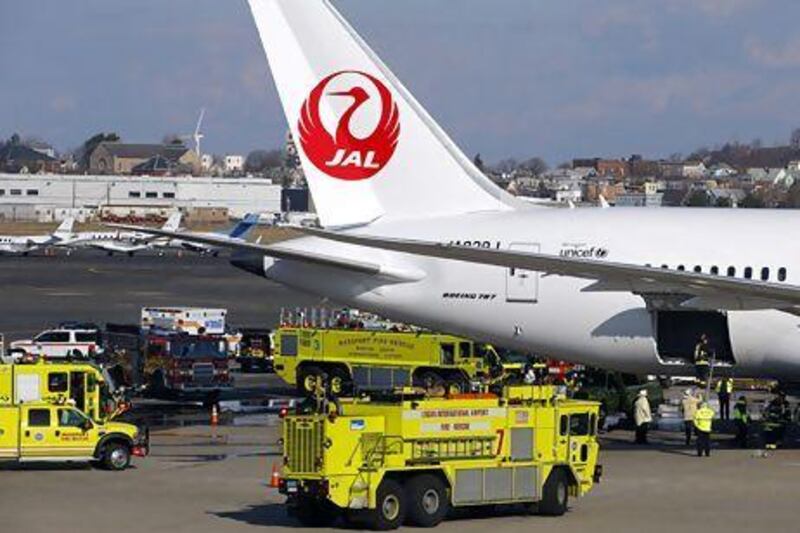When it comes to aviation safety, reputation is everything, and Boeing's flagship next-generation airliner, the 787 Dreamliner, is coming perilously close to losing it.
The 787 is already under a safety review ordered by United States federal aviation administration (FAA) after a battery pack on a Japan Airlines 787 ignited on Monday shortly after the flight landed at Boston's Logan International Airport. Passengers had already left the plane, but it took firefighters 40 minutes to put out the blaze.
There were separate issues on other 787s during the week — fuel and oil leaks, a cracked cockpit window and a computer malfunction showing a brake problem where none existed.
Not to mention the earlier problems with the aircraft's electronics, both during test flights and after customers started flying the plane, all dogging an airliner that was already three years late because of design problems.
Then on Tuesday, an All Nippon Airways (ANA) 787 had to make an emergency landing because of smoke in the cockpit. All 137 passengers evacuated safely, but both ANA and Japan Airlines grounded their 24 787s until further notice
None of the other eight airlines operating the 787, including Qatar Airways, plan to stop flying it, but one of the world's leading aviation analysts, Richard Aboulafia, of the US-based Teal Group, is less sanguine.
"I think you're nearing the tipping point where they need to regard this as a serious crisis," he said. "This is going to change people's perception of the aircraft if they [Boeing] don't act quickly.
"This is the worst new aircraft development programme that Boeing has experienced, when you look back at these troubles and all the delays. There does appear to be a systematic problem either with the manufacturing process or with some of the technologies."
He described the FAA safety audit as, "pretty remarkable," but added that it was"needed to reassure the public".
The FAA could ground the 50 787s that are in service, but Boeing argues that any complicated piece of machinery goes through teething problems. But the unique nature of the jet's construction - and the hype surrounding it - have regulators doing a more thorough review.
"Every new commercial aircraft has issues as it enters service," said Ray Conner, the president and chief executive of Boeing's commercial aircraft division, after the FAA decision.
So what are the issues?
The 787 is the first airliner to be largely constructed from carbon-fibre composites, so it is lighter and stronger and it burns 20 per cent less fuel than existing airliners. But it also has a next-generation electronics system that requires more power than the traditional units to provide power on the ground or in the event of engine problems in the air. Boeing's answer has been to use rechargeable lithium-ion batteries - each about twice the size of a car battery - to start its power unit instead of the heavier system common on other airliners.
But the liquid inside of lithium-ion batteries is flammable, and the potential for fire increases if the battery is depleted or overcharged.
There have also been manufacturing issues. There are 52 suppliers scattered around the globe, each contributing sections to the final assembly lines in Washington state and South Carolina. The process was designed to save time and money, but parts werenot delivered on time, and the quality of some failed to meet standards.
But airlines still like the 787, explainsthe industry analysts, Centre for Aviation (Capa).
"Airlines can deploy the 787 in broadly two ways: the high-profile option of opening new long-haul routes, and the less exciting, but often more practical, replacement of older aircraft," says Capa.
Because it is so economic to fly, it allows for more flights on a route, and, "increased frequency has been shown to disproportionately increase demand".
Boeing has delivered 50 planes so far. Another 798 are on order, and the company plans to ramp up production to 10 787s per month by the end of the year.
Any more production delays could further upset the airlines that are eager to start flying the plane and cost Boeing millions of dollars in contractual penalties.
ANA, United, Air India, Ethiopian Airlines, Japan Airlines, LAN Airlines, LOT Polish Airlines and Qatar Airways are now flying the jet.
Etihad Airways has 41 on order.
"Etihad Airways is in regular contact with Boeing and we are monitoring the pending safety review of the 787 Dreamliner programme," said an Etihad spokesman. "We are confident that any issues with this new aircraft will be resolved before our first is delivered in late 2014."
Qatar Airways, which has 30 on order, also remains confident.
"Our decision to invest in this game-changing airplane, which represents the future of air travel, reflects our firm belief in its unrivalled capabilities and the value it will add to our fleet and network expansion plans," said Akbar Al Baker, the chief executive.





